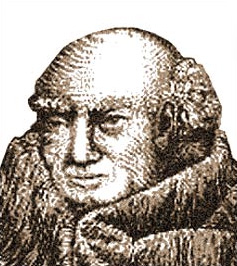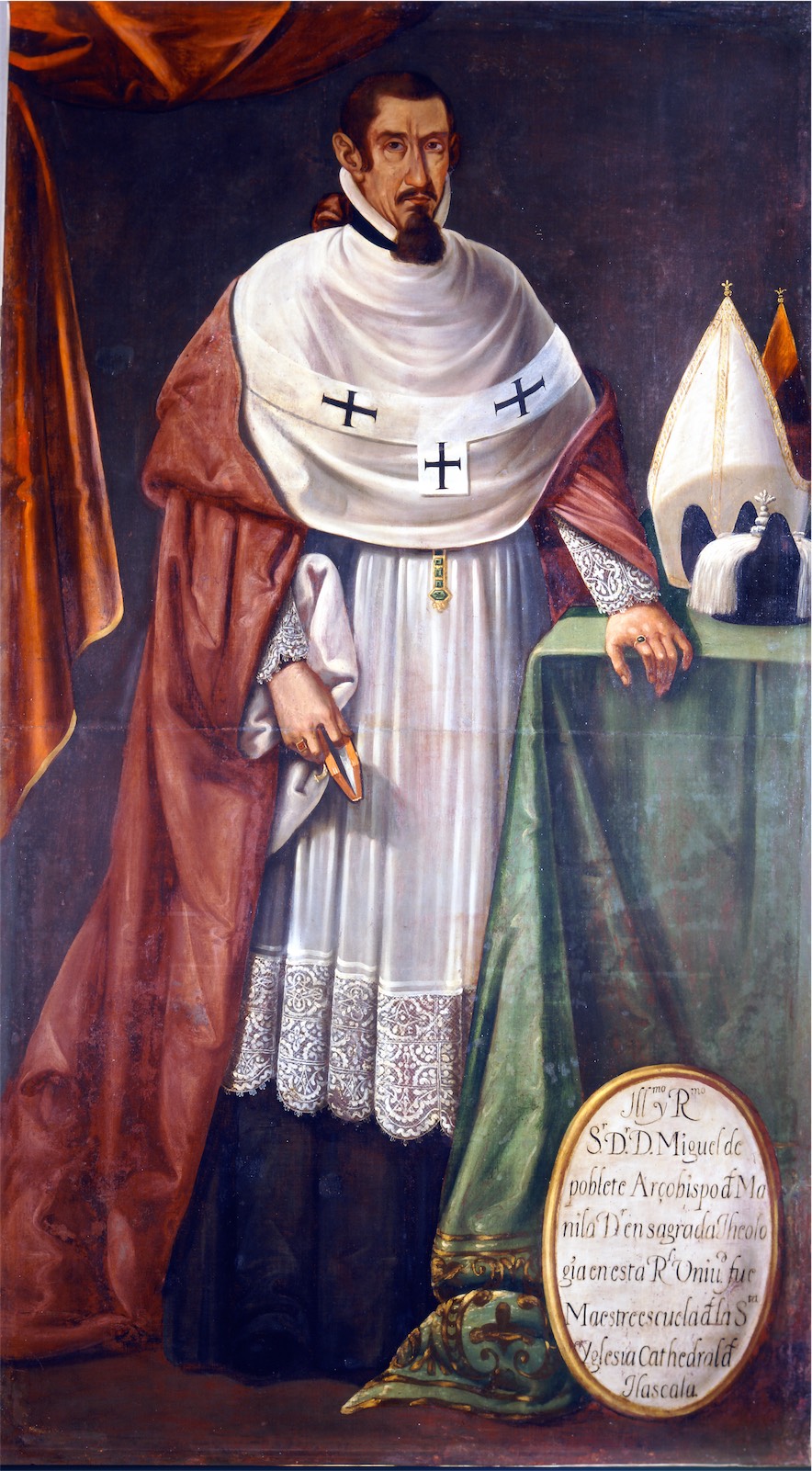|
Wullfadus
Wulfad (died 876) was the archbishop of Bourges from 866 until his death. Prior to that, he was the abbot of Montier-en-Der (from 856) and Soissons (from 858). He also served as a tutor to Carloman, a younger son of King Charles the Bald. Carloman succeeded Wulfad as abbot of Soissons in 860. Wulfad was ordained a priest by Archbishop Ebbo of Reims, who had been deposed in 835 and re-instated in 840. Wulfad was ordained during Ebbo's second incumbency, which ended in 841. He may have served the anti-king Pippin II of Aquitaine, an opponent of Charles the Bald, as a notary during 847–48, a period in which support for Pippin reached a high. In 857, Charles tried to promote him to the vacant see of Langres, but was successfully blocked by Ebbo's successor, Hincmar. In 859, Wulfad was removed from his priestly office, along with all the other priests, deacons and subdeacons ordained by Ebbo, at the synod of Savonnières, held under Hincmar's presidency. Neither Wulfad's suppor ... [...More Info...] [...Related Items...] OR: [Wikipedia] [Google] [Baidu] |
Archbishop Of Bourges
In Christian denominations, an archbishop is a bishop of higher rank or office. In most cases, such as the Catholic Church, there are many archbishops who either have jurisdiction over an ecclesiastical province in addition to their own archdiocese ( with some exceptions), or are otherwise granted a titular archbishopric. In others, such as the Lutheran Church of Sweden and the Church of England, the title is borne by the leader of the denomination. Etymology The word archbishop () comes via the Latin ''archiepiscopus.'' This in turn comes from the Greek , which has as components the etymons -, meaning 'chief', , 'over', and , 'seer'. Early history The earliest appearance of neither the title nor the role can be traced. The title of "metropolitan" was apparently well known by the 4th century, when there are references in the canons of the First Council of Nicæa of 325 and Council of Antioch of 341, though the term seems to be used generally for all higher ranks of bishop, i ... [...More Info...] [...Related Items...] OR: [Wikipedia] [Google] [Baidu] |
John Scotus Eriugena
John Scotus Eriugena, also known as Johannes Scotus Erigena, John the Scot, or John the Irish-born ( – c. 877) was an Irish Neoplatonist philosopher, theologian and poet of the Early Middle Ages. Bertrand Russell dubbed him "the most astonishing person of the ninth century". The Stanford Encyclopedia of Philosophy states he "is the most significant Irish intellectual of the early monastic period. He is generally recognized to be both the outstanding philosopher (in terms of originality) of the Carolingian era and of the whole period of Latin philosophy stretching from Boethius to Anselm". He wrote a number of works, but is best known today for having written ''De Divisione Naturae'' ("The Division of Nature"), or ''Periphyseon'', which has been called the "final achievement" of ancient philosophy, a work which "synthesizes the philosophical accomplishments of fifteen centuries". The principal concern of ''De Divisione Naturae'' is to unfold from φύσις (physis), ... [...More Info...] [...Related Items...] OR: [Wikipedia] [Google] [Baidu] |
876 Deaths
__NOTOC__ Year 876 ( DCCCLXXVI) was a leap year starting on Sunday (link will display the full calendar) of the Julian calendar. Events By place Byzantine Empire * At the invitation of Benevento, the newly-restored Byzantine fleet appears in the waters off Otranto. On the orders of Emperor Basil I, the Byzantines sail up the Adriatic Sea and reconquer part of southern Italy. The city of Bari is occupied in the name of the Byzantine Empire. Instead of holding it for his 'ally' Adelchis of Benevento, Basil makes it the capital of the new Byzantine Theme of Longobardia. Europe * August 28 – King Louis the German dies at Frankfurt, while preparing for war against his brother Charles II ("the Bald"), ruler of the Holy Roman Empire. The East Frankish Kingdom is divided among his three sons: Carloman receives Bavaria and styles himself "King of Bavaria". Louis the Younger receives Saxony (with Franconia and Thuringia), and Charles the Fat receives Swabia (with Ra ... [...More Info...] [...Related Items...] OR: [Wikipedia] [Google] [Baidu] |
Frothar (archbishop Of Bourges)
Frothar or Frotar (Latin ''Frotharius'', French ''Frotaire'') was an Aquitanian prelate in West Francia, who held two different bishoprics and three abbacies during a long career. He was appointed Archbishop of Bordeaux around 859, but Viking raids forced him to abandon his seat in 870. With papal approval, he was transferred to the Archdiocese of Bourges in 876. He died after 893. Frothar was related to the Counts of Toulouse and Rouergue, and perhaps to his predecessor at Bourges, Rodulf. By maintaining control of the abbeys of Brioude and Beaulieu, he preserved his family's influence in southern Gaul during the ascendancy of the Marquis Bernard Plantapilosa. Brioude had been under the protection of the Counts of Auvergne until 874, when Frothar possessed it. King Charles the Bald granted it permission to elect its own abbot and the monks chose Frothar, who was abbot as late as 893. After Frothar's death, the abbey reverted to the control of Duke William I of Aquitaine. Frothar ... [...More Info...] [...Related Items...] OR: [Wikipedia] [Google] [Baidu] |
Archbishop Of Bourges
In Christian denominations, an archbishop is a bishop of higher rank or office. In most cases, such as the Catholic Church, there are many archbishops who either have jurisdiction over an ecclesiastical province in addition to their own archdiocese ( with some exceptions), or are otherwise granted a titular archbishopric. In others, such as the Lutheran Church of Sweden and the Church of England, the title is borne by the leader of the denomination. Etymology The word archbishop () comes via the Latin ''archiepiscopus.'' This in turn comes from the Greek , which has as components the etymons -, meaning 'chief', , 'over', and , 'seer'. Early history The earliest appearance of neither the title nor the role can be traced. The title of "metropolitan" was apparently well known by the 4th century, when there are references in the canons of the First Council of Nicæa of 325 and Council of Antioch of 341, though the term seems to be used generally for all higher ranks of bishop, i ... [...More Info...] [...Related Items...] OR: [Wikipedia] [Google] [Baidu] |
Rodulf (archbishop Of Bourges)
Rodulf (french: Saint Raoul; died 21 June 866) was the archbishop of Bourges from 840 until his death. He is remembered as a skillful diplomat and a proponent of ecclesiastical reform. As a saint, his feast has been celebrated on 21 June. Aquitainian nobleman and monk Rodulf's family was prominent in the region of Angoumois and he himself possessed lands in the Limousin. He was named after his father, the count of Turenne (died 844), and he had four brothers and two sisters as well as an unnamed sibling. He entered the monastery of Solignac as a novice in 823. During the conflict between King Pippin II of Aquitaine and King Charles of West Francia over the inheritance of the Aquitanian kingdom, Rodulf maintained good relations with both claimants, although it is probable that his father fought in the war and is possible that Rodulf himself did as well. Contemporary documents describe him as a "faithful follower" (''fidelis'') of King Pippin. In late 840 Rodulf was elected as a ... [...More Info...] [...Related Items...] OR: [Wikipedia] [Google] [Baidu] |
Monumenta Germaniae Historica
The ''Monumenta Germaniae Historica'' (''MGH'') is a comprehensive series of carefully edited and published primary sources, both chronicle and archival, for the study of Northwestern and Central European history from the end of the Roman Empire to 1500. Despite the name, the series covers important sources for the history of many countries besides Germany, since the Society for the Publication of Sources on Germanic Affairs of the Middle Ages has included documents from many other areas subjected to the influence of Germanic tribes or rulers (Britain, Czech lands, Poland, Austria, France, Low Countries, Italy, Spain, etc.). The editor from 1826 until 1874 was Georg Heinrich Pertz (1795–1876); in 1875 he was succeeded by Georg Waitz (1813–1886). History The MGH was founded in Hanover as a private text publication society by the Prussian reformer Heinrich Friedrich Karl Freiherr vom Stein in 1819. The first volume appeared in 1826. The editor from 1826 until 1874 was Georg He ... [...More Info...] [...Related Items...] OR: [Wikipedia] [Google] [Baidu] |
Recto And Verso
'''' is the "right" or "front" side and ''verso'' is the "left" or "back" side when text is written or printed on a leaf of paper () in a bound item such as a codex, book, broadsheet, or pamphlet. Etymology The terms are shortened from Latin: and ' (which translate as "on the right side of the leaf" and "on the back side of the leaf"). The two opposite pages themselves are called ' and ' in Latin, and the ablative ', ' already imply that the text on the page (and not the physical page itself) are referred to. Usage In codicology, each physical sheet (', abbreviated ''fol.'' or ''f.'') of a manuscript is numbered, and the sides are referred to as ' and ', abbreviated as ''r'' and ''v'' respectively. Editions of manuscripts will thus mark the position of text in the original manuscript in the form ''fol. 1r'', sometimes with the ''r'' and ''v'' in superscript, as in ''1r'', or with a superscript ''o'' indicating the ablative ', ', as in ''1ro''. This terminology has been stan ... [...More Info...] [...Related Items...] OR: [Wikipedia] [Google] [Baidu] |
Folio
The term "folio" (), has three interconnected but distinct meanings in the world of books and printing: first, it is a term for a common method of arranging sheets of paper into book form, folding the sheet only once, and a term for a book made in this way; second, it is a general term for a sheet, leaf or page in (especially) manuscripts and old books; and third, it is an approximate term for the size of a book, and for a book of this size. First, a folio (abbreviated fo or 2o) is a book or pamphlet made up of one or more full sheets of paper, on each of which four pages of text are printed, two on each side; each sheet is then folded once to produce two leaves. Each leaf of a folio book thus is one half the size of the original sheet. Ordinarily, additional printed folio sheets would be inserted inside one another to form a group or "gathering" of leaves prior to binding the book. Second, folio is used in terms of page numbering for some books and most manuscripts that ar ... [...More Info...] [...Related Items...] OR: [Wikipedia] [Google] [Baidu] |
Leiden Universiteitsbibliothek
Leiden University Libraries is a library founded in 1575 in Leiden, Netherlands. It is regarded as a significant place in the development of European culture: it is a part of a small number of cultural centres that gave direction to the development and spread of knowledge during the Enlightenment. This was due particularly to the simultaneous presence of a unique collection of exceptional sources and scholars. Holdings include approximately 5,200,000 volumes, 1,000,000 e-books, 70,000 e-journals, 2,000 current paper journals, 60,000 Oriental and Western manuscripts, 500,000 letters, 100,000 maps, 100,000 prints, 12,000 drawings and 300,000 photographs. The library manages the largest collections worldwide on Indonesia and the Caribbean. Furthermore, Leiden University Libraries is the only heritage organization in The Netherlands with three registrations of documents in UNESCO's Memory of the World Register. :"''Est hic magna commoditas bibliothecae ut studiosi possin ... [...More Info...] [...Related Items...] OR: [Wikipedia] [Google] [Baidu] |
Maximus The Confessor
Maximus the Confessor ( el, Μάξιμος ὁ Ὁμολογητής), also spelt Maximos, otherwise known as Maximus the Theologian and Maximus of Constantinople ( – 13 August 662), was a Christian monk, theologian, and scholar. In his early life, Maximus was a civil servant, and an aide to the Byzantine Emperor Heraclius. He gave up this life in the political sphere to enter the monastic life. Maximus had studied diverse schools of philosophy, and certainly what was common for his time, the Platonic dialogues, the works of Aristotle, and numerous later Platonic commentators on Aristotle and Plato, like Plotinus, Porphyry, Iamblichus, and Proclus. When one of his friends began espousing the Christological position known as Monothelitism, Maximus was drawn into the controversy, in which he supported an interpretation of the Chalcedonian formula on the basis of which it was asserted that Jesus had both a human and a divine will. Maximus is venerated in both the Catholic and Ea ... [...More Info...] [...Related Items...] OR: [Wikipedia] [Google] [Baidu] |
Pseudo-Dionysius
Pseudo-Dionysius the Areopagite (or Dionysius the Pseudo-Areopagite) was a Greek author, Christian theologian and Neoplatonic philosopher of the late 5th to early 6th century, who wrote a set of works known as the ''Corpus Areopagiticum'' or ''Corpus Dionysiacum''. The author pseudepigraphically identifies himself in the corpus as "Dionysios", portraying himself as Dionysius the Areopagite, the Athenian convert of Paul the Apostle mentioned in Acts 17:34. Historic confusions In the early sixth century, a series of writings of a mystical nature, employing Neoplatonic language to elucidate Christian theological and mystical ideas, was ascribed to the Areopagite. They have long been recognized as pseudepigrapha, and their author is now called "Pseudo-Dionysius the Areopagite". Corpus Works The Corpus is today composed of: * ''Divine Names'' ('); * '' Celestial Hierarchy'' ('')''; * ''Ecclesiastical Hierarchy'' ('); * ''Mystical Theology'' ('), "a brief but powerful w ... [...More Info...] [...Related Items...] OR: [Wikipedia] [Google] [Baidu] |








